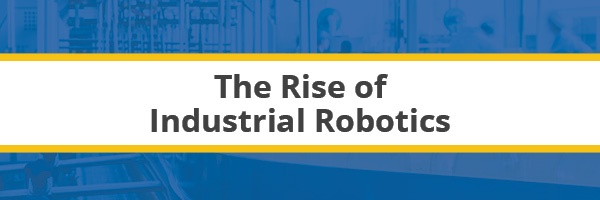
While the Great Recession may have put a dent in several industries, it did push-start the rise of industrial robotics. The sudden spotlight drew attention from all corners and in 2013 more than 5000 patents were passed for robotic technologies. Plus, the annual order for robotics in North America surpassed its 20,000-unit threshold as a result of increased investment by several venture capitalists.
While modern robots have been around since the time man learned to harness electrical energy, they have truly emerged as a utility since the 1980's, citing advanced microprocessor & communication capabilities. A projection by ABI research states that the number of industrial robots sold within the United States will get a boost of 300 percent in less than 10 years. The reasons behind all this are simple: high precision, no pay, no downtime.
Industrial robots have been around on the manufacturing floors since the 70's, and in one way or another have resembled the human arm. These designs are still in use as the primary purpose of an industrial robot is to imitate a human’s limbs.
The field of industrial robotics has come a long way since the 70's as the robots of today are far superior and out-rank their predecessors in terms of:
- Processing power
- Precision & accuracy
- Remote connectivity
- Self-learning & Automation
Even though primitive industrial robots were able to carry out the first three functions, with nominal efficiency, the last one is a Pandora box still unravelling.
The automotive industry has been the top customer for industrial robots due to the amount of repetitiveness required in their hazardous operations. The sector spent $1.2 billion in the year 2016 alone. However, with recent technological breakthroughs as well as human constraints, industrial robotics have emerged as a leading technology in all fields from metals to consumer goods to pharmacy.
In some cases, the reason for their adoption is Nano-precision while in others is the stable input/output chart. But one of the rising reasons for the use of Industrial Robotics is their increased processing power that allows them to practically implement the concepts of Fuzzy Logic & Artificial Intelligence for Self-learning & Automation.
Automation is one of the most sought-out functions in any industry. The ability of an electronic component to intelligently decide the best course of action to varying values of hundreds of variables is an extremely appreciable trait, and the ultimate goal of an industrial robot. While man may be quite far from reaching the highest benchmarks and replicating his own mind, companies like IBM have made the line increasingly thinner with products like “IBM Watson”.
The integration of highly advanced algorithms with ever-increasing and cheap processing power is driving change within the Industrial Robotics sector. Not only do industrial robots shield humans from hazardous situations, they also respond in shorter intervals, and at times don’t get confused while making time-sensitive decisions.
The rise of industrial robots inevitable. They have already taken over manual jobs in several fields & sectors; it is only a matter of time before they start replacing operators in control rooms as well!
Premier Automation designs and implements automatic robotics systems for industrial OEM and End User customers.
To learn more about Premier Automation's robotic capabilities, please visit: premierautomation.com/what-we-do/robotics.



